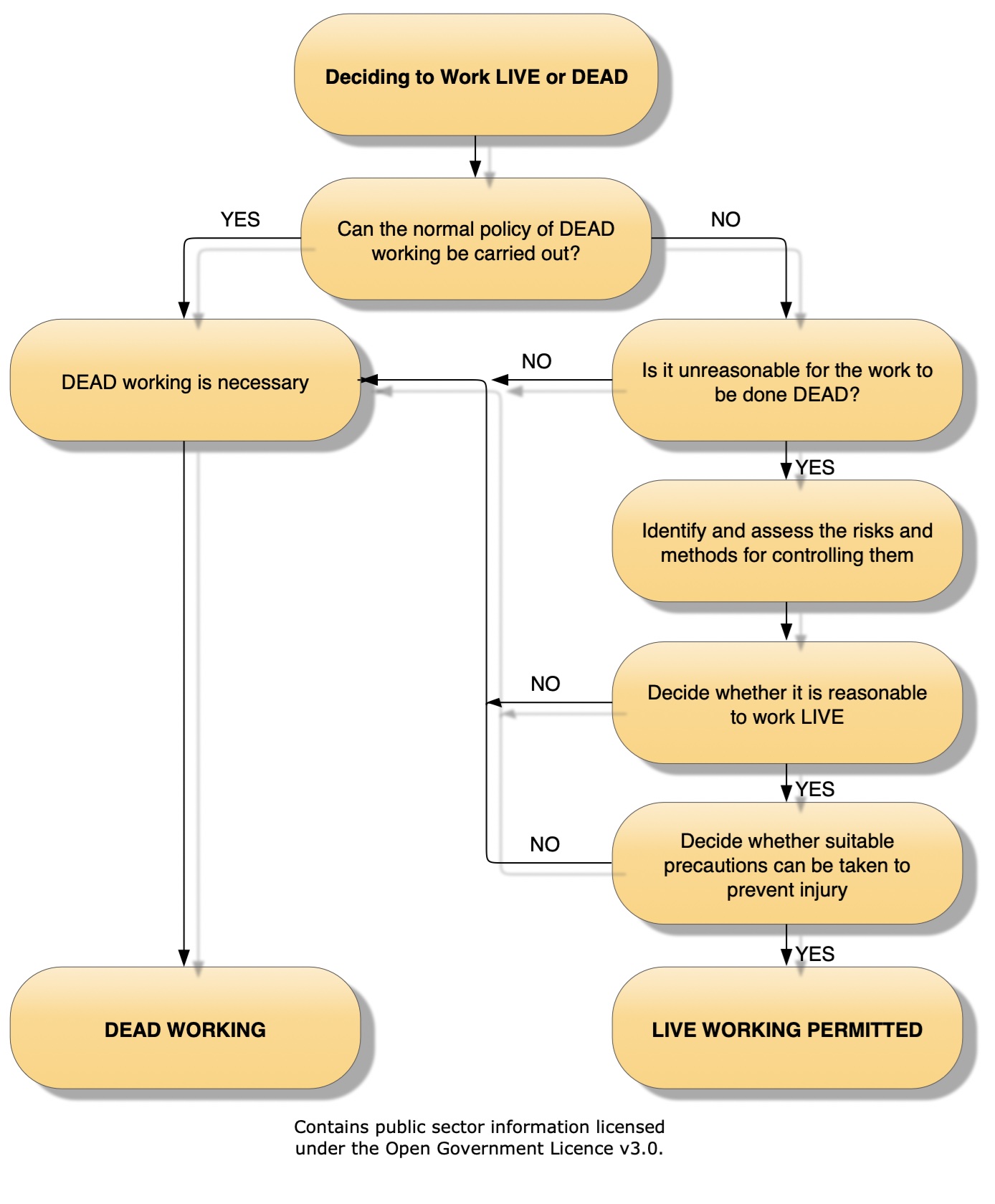6.9.1 Can the normal policy of dead working be carried out?
Work on energised circuits must always be subject to a suitable and sufficient risk assessment. A key part of the risk assessment is the decision to proceed with live work rather than to have equipment dead and isolated for the duration of the work. To help with that decision, I have reproduced guidance from the excellent document, Electricity at Work – Safe Working Practices HSG 85 published by the UK Health and Safety Executive under Open Government Licence v3.0. I can thoroughly recommend the document which can now be obtained free of charge from https://www.hse.gov.uk. I have used the guidance as a framework not only to methodically breakdown the decision but establish the precautions that should be in place particularly in respect of arc flash but also for other electrical hazards. The following illustration, Figure 6.5, describes the process of decision making in greater detail.

Figure 6.5
Work on or near live exposed conductors should rarely be permitted. Many accidents to electricians, fitters, technicians and engineers occur when they are working on equipment that could have been isolated. You should plan and programme the work to allow all jobs to be carried out where possible with the equipment dead. Three conditions must be met for live working to be permitted where danger may arise. If just one of these conditions cannot be met, live working must not be permitted, and dead working is essential. The assessment procedure illustrates this. The conditions are:
- it is unreasonable in all the circumstances for the conductor to be dead; and
- it is reasonable in all the circumstances for the person to be at work on or near that conductor while it is live; and
- suitable precautions (including, where necessary, the provision of personal protective equipment) have been taken to prevent injury.
6.9.2 Is it unreasonable for the work to be done DEAD?
The following examples are taken from HSG 85 to illustrate some circumstances where it is unreasonable to make equipment dead because of the difficulties it would cause:
- It may be difficult, if not impossible, to commission a complex control cabinet without having it energised at some time with parts live (but not exposed so that they may be easily touched);
- It may not be technically feasible to monitor the operation and performance of a control system or to trace a malfunction of such equipment with it dead, i.e., fault-finding;
- A distribution network operator (DNO) needs to connect a new low-voltage service to an existing main, but it might be unreasonable to disconnect many customers. In recognition of the dangers associated with live working, the DNO must have a very strict code of safety rules and procedures to prevent injury;
- Switching off a system, such as the supply to an electric railway track, to carry out maintenance or repair work may cause disproportionate disruption and cost.
- Identify, assess and evaluate the risks and methods for controlling them.
If you have decided that it is unreasonable for the work to be done dead, a risk assessment is necessary. The risk assessment must cover the work on or near the specific equipment and it must be carried out by someone with comprehensive knowledge and experience of the type of work and the means of controlling the risks. If live working can be justified through a rigorous test of reasonableness in conditions a) and b), judgements must be made about suitable precautions against electric shock and the effects of electrical flashover to satisfy the requirements of condition c). Work (which is not confined to just electrical work but includes any work activity) is permitted only if conditions a) and b) and c) are satisfied.
6.9.3 Identify and assess the risks & methods for controlling them.
The first stage of the risk assessment is to identify the hazards, and although not exhaustive, the following highlights some of the more common ones.
- Electrical shock from passage of current through the body, leading to death or injury due to cardiac arrest, shutting down of the respiratory system and heart fibrillation at extremely small currents. This is typically greater than 30mA on alternating current systems. Muscle contraction can occur.
- Internal burns where the current involved is in the order of amperes. The destruction of body tissue and internal organs can occur with the passage of current at around one ampere.
- Arc flash injury can include external burns (i.e., severe burns to the skin), internal burns and intoxication from inhaling hot gases and vaporised metal, hearing damage, eye damage and blindness from the ultraviolet light of the flash as well as many other devastating injuries. Depending on the severity of the arc flash, an explosive force known as an arc blast may also occur and could cause the propulsion of molten metal, equipment parts and other debris.
- Ignition of flammable materials from electrical arcing which could be the clothing that an electrical worker is wearing. Serious third-degree burns have occurred to workers wearing flammable clothing which could become a hazard irrespective of PPE considerations.